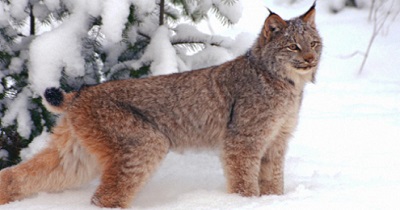Taxonomy

The Canadian lynx is recognized as a least concern species by the IUCN Red List of Threatened Species.
- Kingdom: Animalia
- Phyum: Chordata
- Class: Mammalia
- Order: Carnivora
- Family: Felidae
- Genus: Lynx
- Species: Lynx Canadensis
0
Name
- Common name: Canadian lynx.
- Scientific name: Lynx Canadensis
- Its name comes from the Greek word to “shine”, maybe in reference to their reflective cat eyes.
Physical Features
- The Canadian lynx is a medium size wild cat.
- Canadian Lynx have a dense silvery brown coat in winter and in summer its coat becomes reddish brown.
- These species of lynx have long legs and furry padded paws to help them walk on deep snow and protect them against freezing temperatures.
- Their triangular ears are tipped with long black hair tufts. They have short black tipped tail.
- Canadian Lynx have a strong sense of hearing and vision which they use to spot their prey.
- Their long legs are capable of quick sprints but lack stamina.
Habitat and Distribution
- The Canadian lynx lives in boreal forests and tundra regions in Canada, Alaska and northern U.S.
- These cats build their shelters under rock crevices, fallen trees or under ledges.
- There are 3 subspecies of the Canadian lynx: Lynx Canadensis Canadensis, Lynx Canadensis Mollipilosus and Lynx Canadensis subsolanus.
- The Canadian lynx has gradually disappeared from northern U.S. because of degradation of habitat. Today small numbers can be found in Maine, Montana, Washington, and Colorado.

Canadian lynx distribution map. Source: IUCN Red List of Threatened Species.
Size and Weight
- The Canadian lynx can weight from 18 to 24 lb or 8 to 11 kg. They measure from 31 to 41 in or 80 to 105 cm in length.
Social Behavior
- Lynx are secretive, solitary animals and spend most of their time resting and hunting alone. Occasionally they travel and hunt in small groups. Mothers and cubs are seen hunting together.
- Canadian lynx are nocturnal animals but can be active during the day.
- Like other cats Canadian lynx spray urine and scatter feces to mark their territory.
- They avoid humans and hunt at night, that is the reason they are rarely seen.
Predators
- Bobcats and coyotes.
Threats
- The Canadian lynx has cycles of overpopulation with peak levels 5 times higher than their valleys. The population of lynx and its main source of food, the snowshoe hare, fluctuates at the same time. This cyclical fluctuation happens every 10 years. Adults survive these cycles but their young do not.
- In Canada and Alaska First Nations populations hunt the Canada lynx for its fur. The trapping of Canada lynx is managed for the fur trade through various mechanisms, including closed seasons, quotas and trapping concessions.
Breeding
- Mating takes place once a year and lasts one month ranging from March to May, depending on the weather.
- The female lynx will leave urine in the male’s territory and make loud noises.
- Females will mate with one mate during the season while males will have multiple partners.
- Gestation lasts 64 days. The female Canadian lynx usually gives birth to between 1 and 4 kittens.
The Young
- Cubs are born in May or early June.
- Before birth the mother prepares a den under downed logs or shrubs.
- For their first two weeks cubs are blind.
- They are weaned by 12 weeks and start hunting between 7 and 9 months.
- Cubs leave their mother at around 10 to 12 months.
Diet
- The Canadian lynx diet depend almost entirely, about 60 to 90%, on the snowshoe hare. When they are scarce they will eat medium sized mammals, birds and rodents.
- They consume around 1.3 to 2.6 lb or 600 to 1,200 g of food a day.
- If the Canadian lynx hunts an animal and is unable to consume it at once, it will drag its victim and cover it with leaves to be consumed later.
Life Expectancy
- Canadian lynx live up to 14 years in captivity.
Conservation Status
- The IUCN Red List of Threatened Species lists the Canadian Lynx as “Least Concern”.
- In the United States the Canadian lynx is listed as Threatened under the Endanger Species Act.
Did you know?
The Canadian lynx was once near extinction in Colorado and has been successfully reintroduced. Today they have a self sustained population.
Reference and further research
University of Michigan Museum of Zoology – Lynx canadensis Canada lynx
U.S. Fish and Wildlife Service – Canada lynx (lynx canadensis)
USDA Forest Service – Lynx canadensis
Smithsonian National Museum of National HIstory – Canada lynx, lynx canadensis
